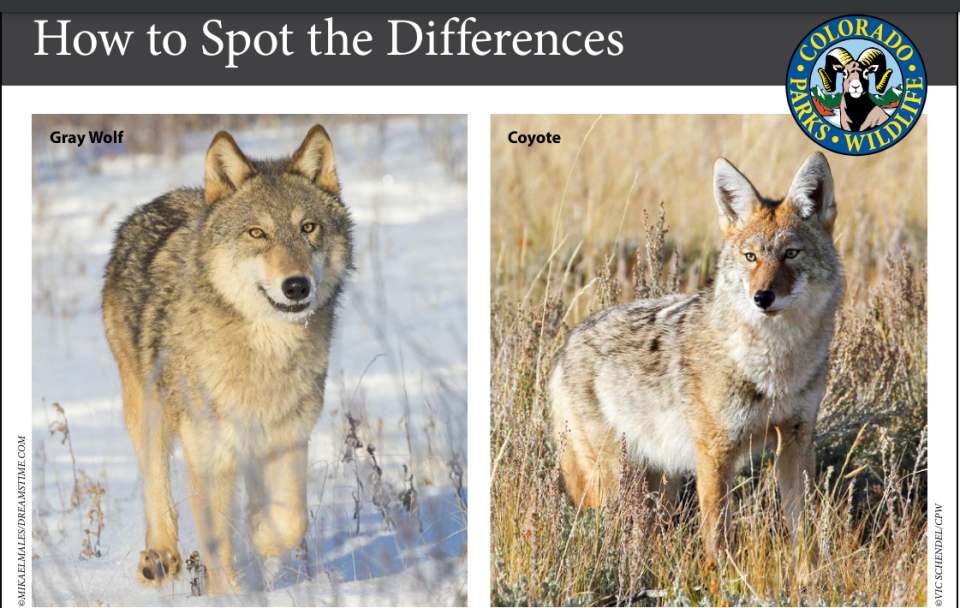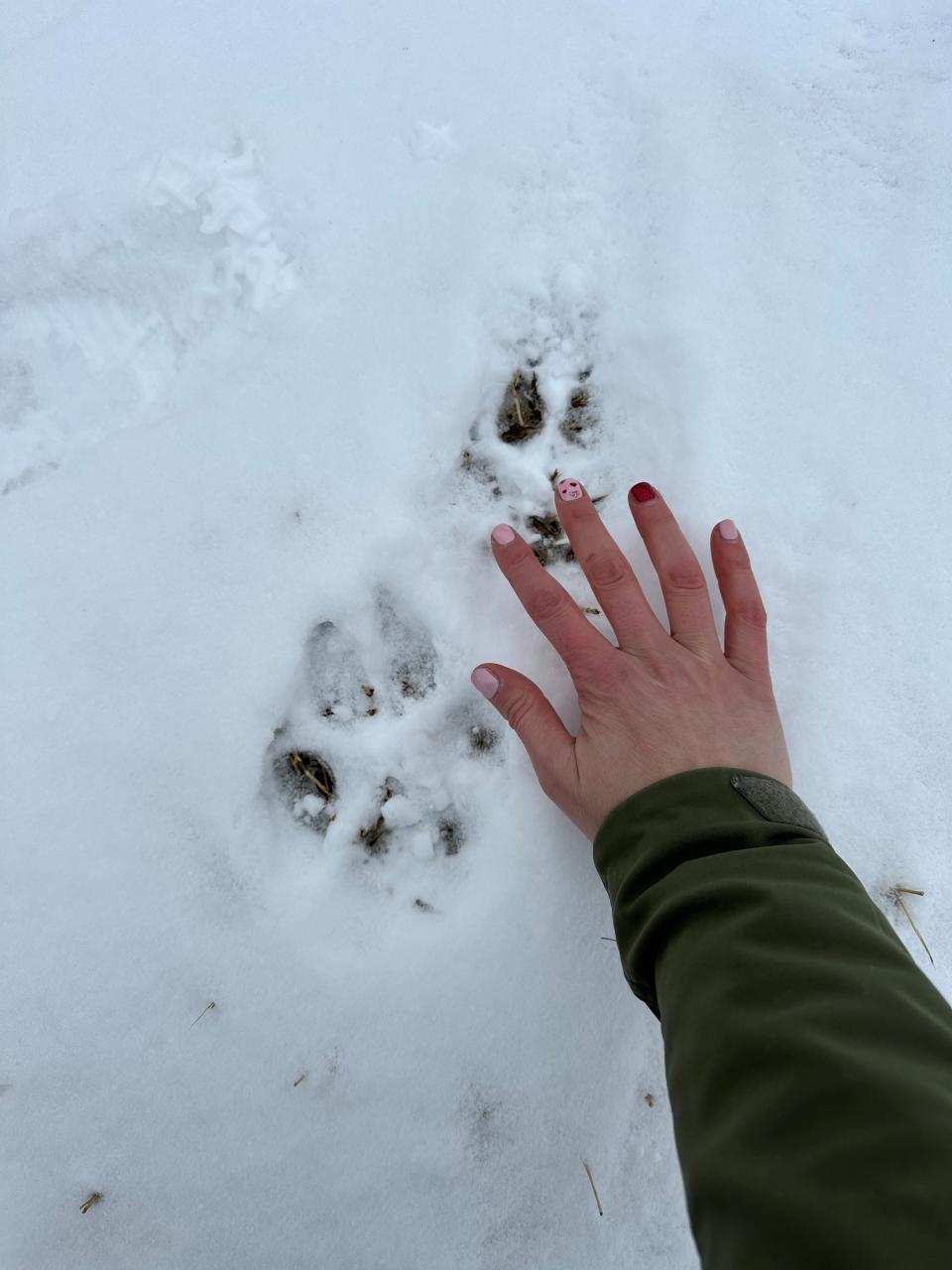Colorado has more wolves, but would you know one if you saw one? Here is what to know
Confirmation of dead wolves in Larimer County, on the Front Range, and Elbert County, on the Eastern Plains, in recent weeks has only heightened public awareness that wide-wandering wolves can show up anywhere in Colorado.
Colorado Parks and Wildlife has received hundreds of calls and wolf sighting reports in recent years.
Those sightings could increase this summer after Colorado reintroduced 10 in late December in recreation-heavy Grand and Summit counties and as the weather warms and more people venture outdoors to recreate.
Here are things you should know about wolves and recreating.

Could you distinguish between a wolf and coyote? They look similar. Here are telltale differences
Many people mistake coyotes for wolves because they look similar and coyotes are much more prevalent in Colorado than wolves.
Here are the differences, according to Colorado Parks and Wildlife and other sources:
Wolves are about twice the size of coyotes. However, smaller wolves can be about the same size as larger coyotes.
Wolves can measure up to 6 feet in length, including the tail, and stand approximately 30 inches in height at the shoulder. Females usually weigh 70 to 80 pounds, while males weigh 95 to more than 100 pounds.
Coyotes typically measure up to 4 feet in length, including tail, and stand closer to 18 inches in height at the shoulder. They generally weigh 15 to 45 pounds.
Coyotes usually have more grayish-brown fur, while a wolf's fur usually is light gray or black.
Wolves have larger and blockier snouts/muzzles and shorter and more rounded ears than coyotes, which have longer, narrower features.
Wolves have distinctively bushier and shorter tails than coyotes.
Wolf tracks are about 5 inches long by 4 inches wide, with four symmetrical toes and identifiable claws.
Coyote tracks are similar but about half that size.
Wolf track paths usually show a direct, purposeful route.
How to report a wolf sighting and what to include in the report
Colorado Parks and Wildlife has a wolf sighting form and encourages the public to report sightings.
The agency received six confirmed wolf sightings between 2004 and 2019. Those confirmed sightings have increased since 2019, when what became the breeding female of the North Park pack was discovered in Jackson County.
Since when that breeding female and a male naturally migrated into Jackson County and gave birth to six pups in spring of 2021, confirmed sightings have increased.
Here are important elements when reporting a sighting:
Clear video and/or photos, while making sure to keep a safe distance.
Photograph or video the tracks and measure them, placing an easily identifiable object next to the tracks.

What to do if you and your pet encounter a wolf
Wolves pose little risk to humans but some risk to dogs, which they see as competition for prey and as encroaching on their territory.
Here are safety tips when recreating:
Make lots of noise if you come and go when wolves are most active — dusk to dawn.
Dogs should be leashed or under strict voice control while recreating.
Bear spray can be effective in warding off an attack.
In the extremely rare case that you encounter a wolf:
Keep visual contact with the animal.
Keep your dog away from the wolf.
Face the wolf but slowly move away (don't run or bend down) to seek shelter.
If it approaches you, make yourself look larger by raising your hands, make loud noises and wave an object such as a hiking stick in front of you.
If attacked, fight back using your fingers or sharp objects on the wolf's most sensitive areas, including underbelly, face and eyes
Where might you encounter a wolf in Colorado?
The reintroduction of wolves has increased their presence in Colorado and wolves wander widely.
Confirmed sightings of naturally migrating and released wolves stretch from the West Slope to the Eastern Plains.
A dead wolf was discovered in Larimer County on April 18.
The wolf found dead in Elbert County in eastern Colorado on April 3 was discovered through blood samples to have wandered from Michigan or Wisconsin.
The highest concentration of wolves remains in the general vicinity of their initial release sites in Grand and Summit counties. That is where the majority of recent wolf depredations on livestock have taken place.
Colorado Parks and Wildlife has released four monthly wolf activity maps showing watersheds in which its 12 wolves (11 after the deceased wolf in Larimer County) were detected travelling via pins from their GPS tracking collars.
The latest map recorded wolf movements March 26 through April 23. That map showed notable movement of a wolf or wolves in Larimer County, expanding eastward in watersheds encompassing roughly the western three-fourths of Larimer County. Those watersheds include one that reaches just east of U.S. Highway 287 north of Fort Collins and another south to U.S. Highway 34 west of Loveland.
It's important to note with the watershed map that watersheds can be quite large. Also, if a collar or collars pings in a watershed, the entire watershed is marked as having a wolf or wolves in it at some point in the last month. It does not necessarily mean a wolf or wolves are currently in those areas.
This article originally appeared on Fort Collins Coloradoan: Colorado has more wolves. Here is how to ID, what to do if you see one

